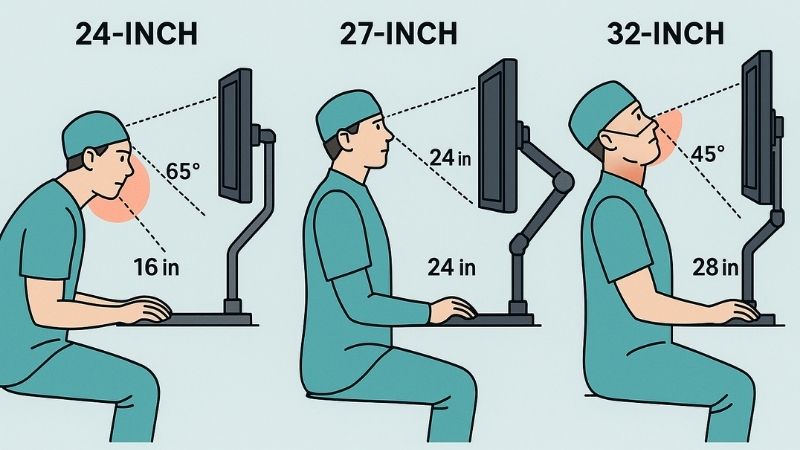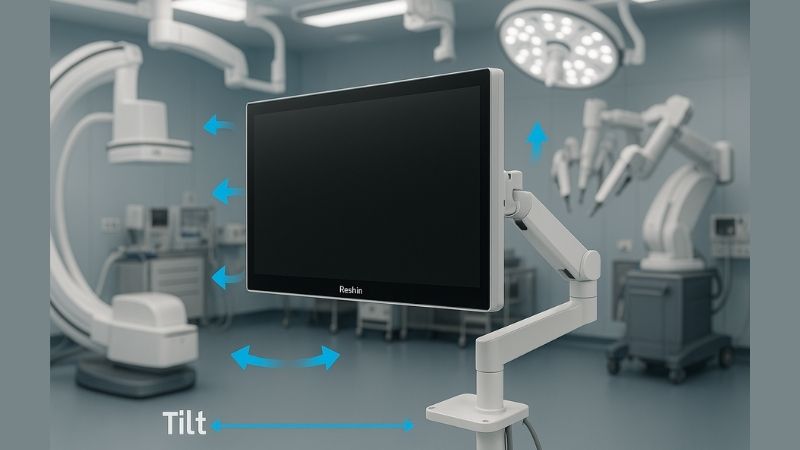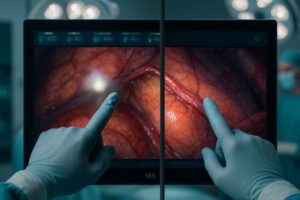Hybrid operating rooms demand flexible setups and precise imaging. A 27-inch surgical monitor balances screen size and spatial needs perfectly, which optimizes workspace ergonomics for long, intricate procedures. Choosing the right monitor size ensures surgeon comfort and efficient workflow, allowing for greater precision and reduced fatigue.
A 27-inch surgical monitor, such as the Reshin MS270P or MS275P, is ideal for ergonomic setups in hybrid ORs because it balances ample viewing space with spatial efficiency. This size allows for optimal focal distance, supports multi-source imaging without overwhelming the user, and facilitates flexible mounting options, reducing physical strain.

As President of Reshin, I understand how vital ergonomics are in the demanding OR environment. We’ve seen firsthand how the right monitor can improve a surgeon’s focus and reduce physical strain. Let’s examine the ergonomic advantages of a 27-inch surgical monitor and why it’s often the sweet spot for hybrid OR environments.
Why is 27 inches an optimal size for ergonomic viewing?
Larger monitors can strain the eyes and neck due to the need for frequent head movements to view the entire screen. Smaller screens may require excessive leaning, which causes posture problems and can lead to discomfort over extended periods.
A 27-inch monitor provides a balanced screen size, allowing for comfortable viewing without straining the eyes or neck, making it ideal for long surgical procedures where maintaining focus and minimizing physical stress are paramount.

"A 27-inch surgical monitor1 strikes a crucial balance between screen size and spatial constraints, making it ideal for hybrid ORs2 where space is shared with multiple imaging systems." In a hybrid OR, space is often at a premium. A 27-inch monitor allows the surgeon to view the entire screen without excessive head or eye movements, crucial for minimizing strain during long operations. This size also facilitates easier integration with other equipment and imaging systems. For example, the Reshin MS270P (FHD) and MS275P (4K) offer the ideal viewing experience without taking up too much valuable space in the OR. Furthermore, the relatively compact size of a 27-inch monitor makes it easier to position and adjust, which is especially important when multiple surgeons or staff members need to view the screen from different angles. The key is to maximize visibility while minimizing the physical demands on the surgical team.
How does screen placement impact surgeon posture?
Poor screen placement can lead to awkward postures, which can cause musculoskeletal problems and reduce focus during surgery, ultimately affecting the surgeon’s performance and potentially the outcome of the procedure.
Proper screen placement ensures neutral body positioning, reducing the risk of neck and back strain, leading to better concentration and surgical outcomes, and supporting long-term physical health for the surgical team.

"Its moderate size allows for optimal focal distance3, helping reduce neck strain and eye fatigue during long procedures." A 27-inch monitor allows for flexible placement on ceiling arms, wall mounts, or mobile carts, enabling surgeons to position the screen at an optimal viewing distance and angle, tailored to their individual preferences and the specific requirements of the surgery. The smaller footprint of the Reshin MS270P and MS275P allows for a more adaptable workspace, minimizing the risk of poor posture and enhancing overall ergonomic comfort4. Consider a scenario where a surgeon is performing a minimally invasive procedure using endoscopic tools. Proper screen placement5 ensures that they can maintain a comfortable, neutral posture while viewing the surgical site, reducing the risk of fatigue and improving their precision.
What role does pixel density play in reducing visual fatigue?
Lower pixel density can cause images to appear blurry or pixelated, leading to eye strain as the surgeon tries to focus on the details, ultimately affecting their ability to discern critical anatomical structures.
High pixel density, especially in 4K models like the MS275P, ensures sharp images, which reduces visual fatigue and allows surgeons to maintain focus for longer periods, enhancing their ability to perform complex procedures with greater accuracy.

Visual acuity is key to comfort and precision. Higher resolutions make the image sharper and more realistic. "Compared to larger screens, a 27-inch display allows easier ergonomic mounting—whether on ceiling arms, wall mounts, or mobile carts—without obstructing other equipment." The Reshin MS275P, with its 4K resolution6, offers exceptional clarity and detail on a manageable 27-inch screen. This reduces eye strain7 and allows surgeons to focus on intricate details with ease. For instance, when viewing fine blood vessels or nerve structures during a delicate surgery, the enhanced clarity provided by a high-pixel-density monitor can make a significant difference in the surgeon’s ability to perform the procedure safely and effectively.
How does monitor adjustability enhance workflow flexibility?
Static monitors limit adaptability to different surgical needs and surgeon preferences, reducing overall efficiency and potentially compromising the surgeon’s comfort and ability to perform optimally.
Adjustable monitors offer tilt, swivel, and height options, adapting to different surgical requirements and preferences, which boosts workflow flexibility and surgeon satisfaction, contributing to a more efficient and comfortable surgical environment.

"Its size supports effective Picture-in-Picture8 or Picture-by-Picture viewing modes without overwhelming the field of view, crucial for multi-modality integration." The adjustability of the Reshin MS270P and MS275P enhances their utility in hybrid ORs9. With easy adjustments, surgeons can optimize the screen position for various procedures and viewing angles. This adaptability contributes to a more streamlined and ergonomic workflow. Consider a situation where a surgeon needs to switch between viewing live video from a surgical camera and reviewing pre-operative imaging studies. An adjustable monitor10 allows them to quickly and easily reposition the screen to optimize their viewing angle for each task, minimizing disruption to the surgical workflow.
Can a 27-inch monitor support multi-source imaging ergonomically?
Overcrowded screens can overwhelm the surgeon, reducing their ability to process information effectively, especially when managing multiple imaging inputs, leading to errors or delays in critical decision-making.
A 27-inch monitor effectively supports multi-source imaging, offering Picture-in-Picture or Picture-by-Picture modes without overwhelming the surgeon, maintaining clear visibility and reducing cognitive overload, which is essential in complex surgical procedures requiring real-time information from multiple sources.

"Ergonomics in hybrid ORs isn’t just about physical comfort—it’s also about positioning displays to minimize cognitive load11 and enable faster decision-making. A 27-inch display12 fits well into that equation." The Reshin MS270P and MS275P support multiple inputs, enabling the display of various imaging modalities simultaneously. The 27-inch size ensures that all sources are visible without cluttering the screen, allowing surgeons to make quick, informed decisions, improving overall operational efficiency. For example, during a cardiac intervention, a surgeon might need to view live fluoroscopic images, hemodynamic data, and ECG tracings simultaneously. A 27-inch monitor with multi-source capabilities13 allows them to view all of this information clearly and concisely, enabling them to make critical decisions with confidence.
Conclusion
The 27-inch surgical monitors from Reshin, such as the MS270P and MS275P, offer an ideal ergonomic solution for hybrid operating rooms, enhancing both physical comfort and workflow efficiency for surgeons, ultimately contributing to better patient outcomes.
For more information or to request a demo, contact Reshin at martin@reshinmonitors.com.
- Explore the advantages of a 27-inch surgical monitor, including its impact on surgeon comfort and operational efficiency in hybrid ORs. ↩
- Learn about hybrid ORs and their role in enhancing surgical procedures through advanced imaging and equipment integration. ↩
- Understanding optimal focal distance can enhance ergonomic practices for surgeons, reducing strain and improving performance. ↩
- Exploring ergonomic comfort can reveal its crucial role in enhancing surgeon efficiency and reducing fatigue during procedures. ↩
- Learning about screen placement can significantly improve surgical outcomes by ensuring better visibility and comfort for surgeons. ↩
- Exploring the benefits of 4K resolution can help you appreciate its impact on surgical outcomes and technology advancements. ↩
- Learning about eye strain reduction techniques can improve comfort and performance for medical professionals in high-stakes environments. ↩
- Explore how Picture-in-Picture enhances surgical displays for better multitasking and efficiency in the operating room. ↩
- Learn about hybrid ORs and how they integrate advanced technology for improved surgical outcomes. ↩
- Discover the impact of adjustable monitors on surgical workflows and their role in enhancing ergonomics and efficiency ↩
- Understanding cognitive load can help improve surgical practices and enhance patient outcomes in hybrid ORs. ↩
- Explore how a 27-inch display enhances decision-making and efficiency in hybrid ORs, crucial for surgical success. ↩
- Learn about the advantages of multi-source capabilities in surgical displays for better information visibility and decision-making. ↩



